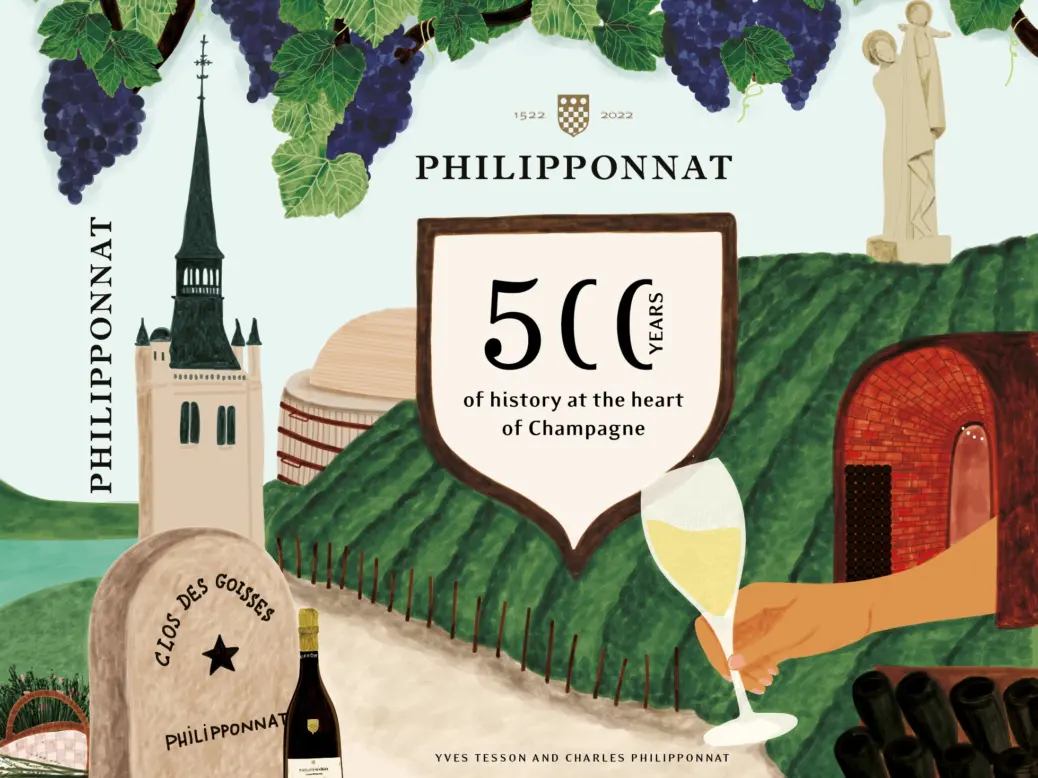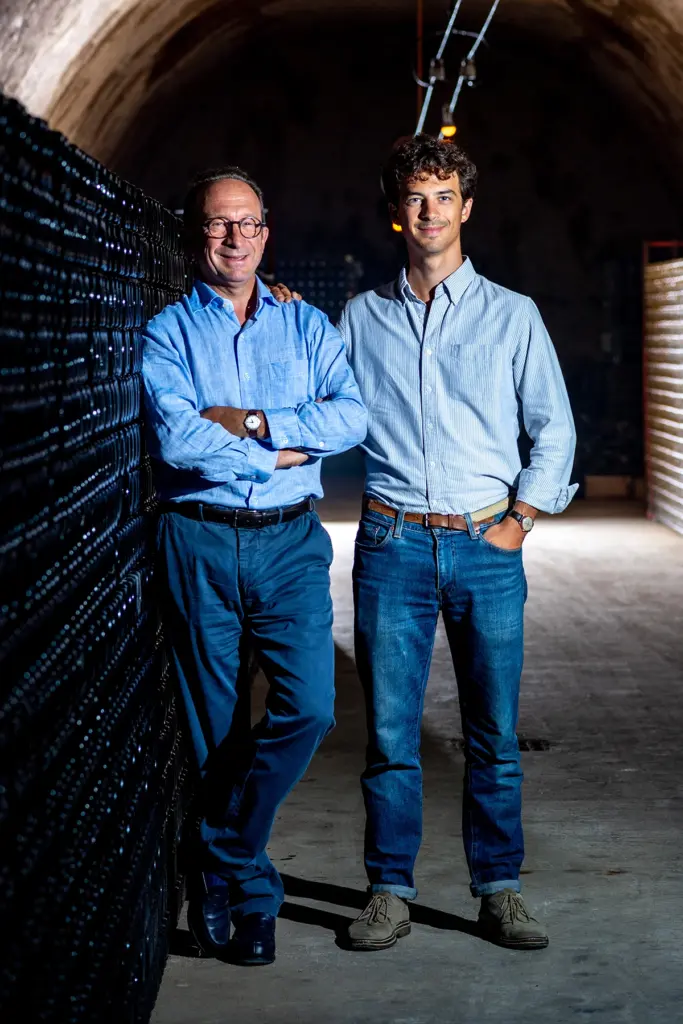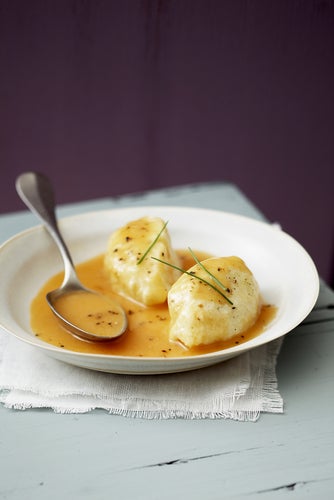
Champagne Philipponnat has a Janus-like appeal. It is a négociant that behaves like a grower; it is part of a large group (Lanson BCC, the abbreviation standing for Boizel Chanoine Champagne) that maintains an independent spirit and, prima facie at least, an air of autonomy; and finally it is a house that is famous above all for its Clos des Goisses Cuvée—but it is far from a one-trick pony.
The fact that Philipponnat is now an honorary member of the circle hallowed above all others by anglophone markets (the holy trinity of Bollinger, Pol Roger, and Louis Roederer) is largely down to the charisma and chutzpah of one man, Charles Philipponnat, coauthor of this highly readable history of the eponymous house, which in 2022 celebrated its 500th anniversary—a not-insignificant achievement.
The cover of this short book, A3 in format, deceives with its playful, almost childish drawings. It has been coauthored by the journalist Yves Tesson, but one does not sense much by way of ghost-writing; on the contrary, one detects the distinctive timbre of Charles’s voice throughout, and that voice is urbane, erudite, and witty. These are good qualities in a book of this kind, all of which, albeit subtly, desist from hagiography and thereby give a very real sense of the quotidian challenges of a medium-sized Champagne house, with environmental and commercial factors spilling out from the historical backdrop. There is no lack of opinion, either, as where Charles cleverly challenges the perception that, almost as a reflex, equates Champagne with luxury. A thorough and honest description of the modus operandi—in the vineyard and elsewhere—and an analysis of the difficulties equated with a marginal climate, both serve to humanize the product, not with sensational anthropomorphology but rather by means of a gentle portrait of those involved in its creation. The human factor is key and has been enunciated with dignity.
That human factor stretches over no fewer than 16 generations, with nepotism, wars, riots, accusations of collaboration, and bankruptcy all playing their part. The anthropological backdrop has, as its corollary, the evolution of the product itself, and one of the most successful features of the first three scene-setting chapters is the panning in and out of familial focus, the aperture skillfully manipulated to give genuine contextual relevance to this hardy dynastic perennial. “Champagne was born in the high aristocracy under the Regency, in a time of depravity; it was very expensive and reserved for the libertine elite. [Yet at the same time] it is a wine of the Enlightenment.” If one can understand the concept of enlightened depravity, one should also be able to understand why Charles is keen to move away from it! “Champagne transcends class […]. True luxury is quite simply quality, beautiful things bespoke. I don’t want people to say that Philipponnat is a luxury brand, inaccessible. I want it to be shared.” One may have to await the final chapter for this mission statement, but its message has been threaded, with great dexterity throughout the book.
Le Léon between Aÿ and Dizy
The first three chapters outline the struggles encountered by Charles’s forebears, traced, without the faintest whiff of genealogical prestidigitation, back to Avpril Le Philipponnat, a Swiss army captain who was born in around 1490 and who was responsible, in 1522, for the purchase of a vineyard located between Aÿ and Dizy. The vineyard is called Le Léon, is still owned by the family, and, in exceptional years, is vinified and bottled as a separate cuvée. I for one can vouch for the exceptional quality of its latest iteration, the 2015. These three chapters very successfully interweave the family’s progress with a broader historical backdrop; we learn of the influence of the German merchants, we meet King Henri IV (the soi-disant king of Aÿ, where he kept one of his many mistresses, allegedly), the Medici Pope Leon X, who lent his name to the vineyard we have been discussing, and the Sun King, Louis XIV, no less, whose doctor prescribed Champagne over Burgundy as an antidote to gout. The deprivations of phylloxera and war are described, their effects on Champagne (“waves of stubble on a sea of chalk”) throwing the familial travails into sharp focus. We meet several significant ancestors (the family tree at the beginning of the book is a lifesaver), including Auguste Philipponnat, who, in 1851 created the Philipponnat Tambourt Négociant company, a direct descendant of the current house, and then Gustave Philipponnat, the mayor of Aÿ, whose influence on the evolving legislative bodies (the AVC, Association Viticole Champenoise, is a direct forebear of today’s CIVC) helped crystallize the often-complicated relationships between the workers and the négociant houses in the region.
Entering the 20th century, the brothers August and Pierre feature prominently among the dramatis personae; they were responsible for the creation, in Mareuil-sur-Aÿ in 1913, of the house as we know it today. The backdrop becomes stained by war and the German incursions, with the further complication of the Great Depression and Prohibition threatening and, at times, completely curtailing the commercial machine. Pierre had to walk the tightrope of German occupation at a time when commercial activity, difficult in the extreme, also often fell to the mercy of accusations of collaboration. The most significant part of Pierre’s legacy, however, was the purchase of the (already celebrated) Clos des Goisses vineyard, which he managed, somehow, to pull off in the procellous atmosphere of 1935 France, and for an exceptionally good price to boot.

The two key characters to emerge from the war-torn wreckage are René Philipponnat (born in 1913 and the father of author Charles) and Michel Collard (born in 1921 and husband of Pierre’s daughter Monique). René’s significance is somewhat tangential; he became one of Dom Pérignon’s most influential cellar masters, a job from which he retired as late as 1977, but it was René who instilled a philosophy in his son Charles and in the chef de cave at Philipponnat, Louis Bouland, that underwrites the quality of the house as we know it today. Michel Collard did more than any other to encourage the flight to quality; auxiliary labels were shunned, growers were paid bonuses for the quality of their grapes, and the art of blending was refined, with only the first pressings permitted. An aesthete (he is also described as a dandy), Collard was a keen musician (he compared the Champagne assemblage process to musical composition and was said to bring “the grace of a poet” to the house) and socialite (he took a major stake in the Taillevent restaurant in Paris), but he was perhaps less attentive to the financial ledgers, which led, eventually, to selling up. Selling up three times, one should say, the last of which was to the Lanson-BCC Group and the murky waters of large corporate ownership. This meant difficult times for the house, and not that long ago, since this final sale took place as late as 1998.
The end of the road for Philipponnat? Not at all. Enter our hero, Charles, who had been working at Moët & Chandon. “God writes straight with crooked lines,” he says, and the five centuries were not without challenges, to put it mildly. All for a purpose, and that purpose celebrates a fascinating history and builds upon an impressive heritage. “My job has been to rebuild and not to dismantle,” says Charles, and he goes on to describe the work in both vineyard and winery that has been undertaken to achieve this aim.
We meet the vineyard manager, Aurélia Jamain, and learn about the “reasoned” organic viticulture employed to limit the challenges posed by oidium, botrytis, and nematodes, inter alia—a pragmatic approach focused on natural products only and now formalized by Haut Valeur Environmental (HVE) accreditation. Then into the winery we go for an encounter with long-serving cellar master Thierry Garnier and a discussion on the reintroduction of oak barrels during the vinification process (228-liter pièces, together with 600-liter demi-muids and larger foudres); on the developments of the maturation of reserve wines (a third of which are barrel-aged in a perpetual reserve, a variant on the solera); on dosage, significantly reduced and now constant (8.5g/l for NV and 4.25g/l for the various Vintages); and finally on the increased significance of the rosé wines. Thierry then introduces the additions to the lineup: the 1522, the name of which should come as no surprise, but also the Blanc de Noirs and the other single-vineyard wines that complement Le Clos des Goisses (Les Cintres, Le Léon, and La Rémissionne). Behind it all, the guiding hand of Charles, now joined by his son François (the face of the 16th generation) and their ongoing efforts to ensure that the wines are well positioned across the word. For once, the phrase “tireless ambassador” seems far from inappropriate to describe Monsieur Philipponnat; exports have long been an important part of the business, making up more than two thirds of overall sales. Key to his thinking at all times is the need to preserve the familial, artisan image and an aura of exclusivity (he’s doing well on all three counts) but also to spread the word, especially in the Michelin restaurants of the world. Philipponnat is one of the smallest of the coterie of top-class grandes marques, one should remember.
A terroir and microclimate gift
And so to Chapter Five, devoted, as one might expect, to Clos des Goisses. The significance of this single plot, with its Burgundian echoes, is given historical context with discussion on the origin of the name: La Goiss family, maybe? What about the French expression de quin-gois, meaning crooked? Or maybe poetically a variant on Clos de l’Angoisse? Nobody really knows. More significant is the steep (45 degrees) aspect, the southern exposure (close to the River Marne), and the purity of the belemnite chalk; this unique terroir and microclimate gift wines with potential alcohol at harvest averaging more than 11% and sometimes over 12%—that is to say, on average, a degree and a half higher than all the surrounding plots. The vineyard is therefore presented as something of an “aberration.” “The terroir,” writes Charles, “is indeed atypical and constraining, with extreme and unusual qualities, standing as an exception to established ideas, which it transcends rather than contradicts.” It is as steep as Savoie or the Mosel, or Côte-Rôtie. Its vines are notoriously difficult to farm; winches, sledges, and caterpillar carriers all play their part; it is too precipitous for the horse and plow, alas. Long recognized as a single source of superlative Champagne, Goisses did not actually become Clos des Goisses until the 1950s, still early enough for its first outing thus (1951) to appear almost 30 years before its equally famous counterpart, Krug’s Clos de Mesnil. Today, there are between 40 and 50 wines entitled to be labeled as a clos across Champagne, all glorying in what was once a radical and more obviously Burgundian concept of the single (walled) vineyard. This has been one of the most significant developments in a region that has been long dedicated to cross-regional blending.
Clos des Goisses has a lot to answer for, then, and answer it does, with great eloquence, with every vintage declared since 1988. Respect for biodiversity, allied to the benefits of massal selection and plot-by-plot vinification (there are 14 semi-autonomous plots including Les Cintres) underwrite the style, even if a spirit of pragmatism is sometimes required. The tricky 2011 vintage, for example, was a blanc de noirs, such were the problems encountered with the Chardonnay. Normally, the blend reflects the planting itself—70 percent Pinot Noir and 30 percent Chardonnay—but in 1996 and 2008, terrific vintages both, the honors were shared 50/50. Volumes made can reflect (informally) the quality of the vintage and can vary from 3,000 to 30,000 bottles, averaging somewhere between 20,000 and 25,000. The house once again led the way in 2021 when Clos des Goisses was the first Champagne to be offered on the Place de Bordeaux, a successful move, now followed by others, which has helped to seal an already impressive reputation on the world stage. A further innovation has been the introduction of the LV (as in long vieillissement) series of late-disgorged vintages, the 1997 Clos des Goisses LV the latest manifestation. A fantastic range, powerful in youth and complex in maturity; take your pick.Charles quotes Corneille, who reminds us that “for wines nobly born, valor doesn’t await the passing of years.” But it can do…
This reputation of Clos des Goisses is significant, of course, but Charles wants more than its “reflected glory.” In a sense, even more significant has been the work put in to improve the Royale Réserve Brut Non-Vintage stalwart, maybe once seen as somewhat rustic in style. Rusticity has now ceded to power; power in turn deferential to balance and elegance. The entire range is now worthy of its pennant.
The book finishes with a series of endorsements from seven admirers of Philipponnat, including Michelin chefs Jérôme Banctel and Gérard Boyer, Zurich-based sommelier Marc Almert, critic William Kelley, and, closer to home, the son of Michel Collard, Jean-Philippe, who has taken his father’s love of music to a logical conclusion and has become an international concert pianist. He recalls how his father used to put on concerts during harvest-time: “There was chaos everywhere, with semi-quavers and grapes getting mixed up,” he jokes. What fun it must have been to attend such a concert, its ode to joy effortlessly and almost inadvertently capturing the essence of what has, very slowly, very surely, made Philipponnat such a successful Champagne house. Charles’s enlightened guidance has underwritten it all—quite literally, in the case of this happy book.
Philipponnat: 500 Years of History at the Heart of Champagne
Yves Tesson and Charles Philipponnat
Published by Terre de Vins Editions
80 pages; $30 / £25 / €25






